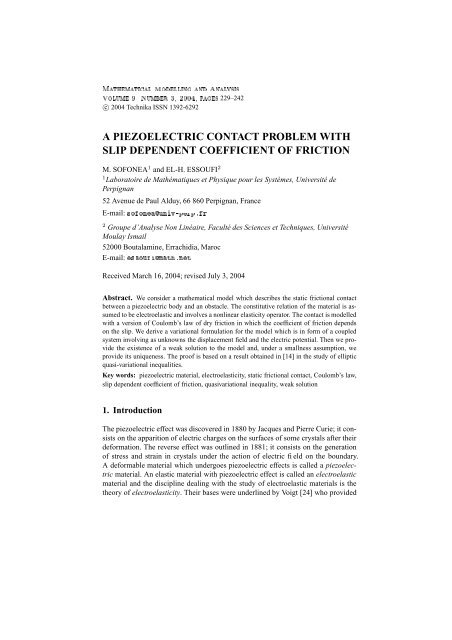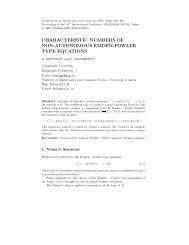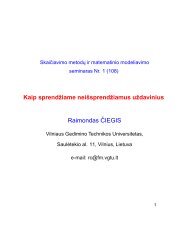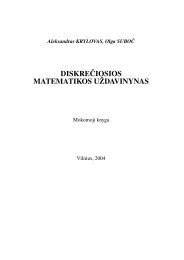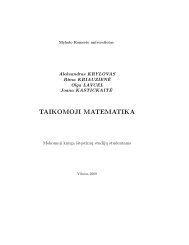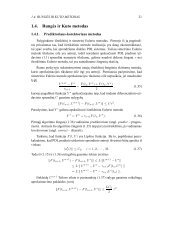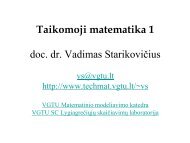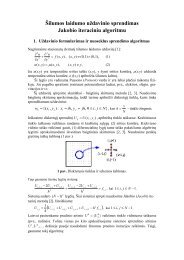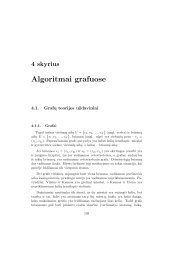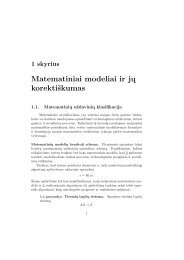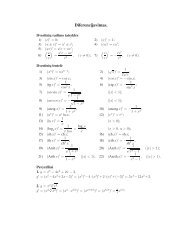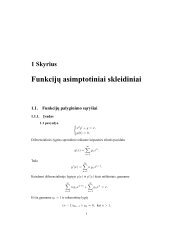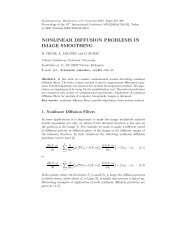a piezoelectric contact problem with slip dependent coefficient of ...
a piezoelectric contact problem with slip dependent coefficient of ...
a piezoelectric contact problem with slip dependent coefficient of ...
Create successful ePaper yourself
Turn your PDF publications into a flip-book with our unique Google optimized e-Paper software.
§©¤¤¦¡¡ ¢¡¤£¦¥¦§©¨¡¤£¦¡!"#¤$¦¨%§'&)($¦¨+*§©,¢-#.0/©121©3.546¡§©229–242c○ 2004 Technika ISSN 1392-6292A PIEZOELECTRIC CONTACT PROBLEM WITHSLIP DEPENDENT COEFFICIENT OF FRICTIONM. SOFONEA 1 and EL-H. ESSOUFI 21 Laboratoire de Mathématiques et Physique pour les Systèmes, Université dePerpignan52 Avenue de Paul Alduy, 66 860 Perpignan, FranceE-mail: 7©8298©:¦;:5?¤@5ACB;ED2BGFH92D2 Groupe d’Analyse Non Linéaire, Faculté des Sciences et Techniques, UniversitéMoulay Ismail52000 Boutalamine, Errachidia, MarocE-mail: ;77©8©>9?E=¤I5
230 M. S<strong>of</strong>onea, El-H. Essoufithe first mathematical model <strong>of</strong> a linear elastic material which takes into account theinteraction between mechanical and electrical properties.General models for elastic materials <strong>with</strong> <strong>piezoelectric</strong> effects can be found in[10, 11, 12, 22, 23] and, more recently, in [1, 21]. Currently, there is a considerableinterest in frictional <strong>contact</strong> <strong>problem</strong>s involving <strong>piezoelectric</strong> materials, see forinstance [2, 9] and the references therein. Indeed, situations which involve <strong>contact</strong>phenomena abound in industry and everyday life. The <strong>contact</strong> <strong>of</strong> the braking pads<strong>with</strong> the wheel, the tire <strong>with</strong> the road and the piston <strong>with</strong> skirt are just three simpleexamples. Because <strong>of</strong> the importance <strong>of</strong> <strong>contact</strong> processes a considerable effort hasbeen made in their modelling and the engineering literature concerning this topicis extensive. However, there are very few mathematical results concerning <strong>contact</strong><strong>problem</strong>s involving <strong>piezoelectric</strong> materials and therefore there is a need to extendthe results on models for <strong>contact</strong> <strong>with</strong> deformable bodies to models for <strong>contact</strong> <strong>with</strong>deformable bodies which include coupling between mechanical and electrical properties.The aim <strong>of</strong> this paper is to provide such an extension. Indeed, we consider herea model for the process <strong>of</strong> frictional <strong>contact</strong> between an electrolastic body, which isacted upon by forces and electric charges, and a foundation. The process is static,the <strong>contact</strong> is frictional and it is modeled <strong>with</strong> a version <strong>of</strong> Coulomb’s law <strong>of</strong> dryfriction in which the <strong>coefficient</strong> <strong>of</strong> friction depends on the <strong>slip</strong>. Such kind <strong>of</strong> dependencewas pointed out in [18] in the study <strong>of</strong> the stick-<strong>slip</strong> phenomenon and wasconsidered in various papers, see for instance [16, 19]. Frictional <strong>contact</strong> boundaryvalue <strong>problem</strong>s <strong>with</strong> elastic materials and <strong>slip</strong> <strong>dependent</strong> friction were considered in[3, 6] in the static case and in [4] in the quasistatic case. Here we extend the frictionalmodel in [3] to the case <strong>of</strong> nonlinear electroelastic materials. Taking into account the<strong>piezoelectric</strong> behavior <strong>of</strong> the body consists the main trait <strong>of</strong> novelty <strong>of</strong> the model. Wederive a variational formulation <strong>of</strong> the model then we prove its weak solvability and,under an additional assumption, its unique solvability. As in [3], the pro<strong>of</strong> <strong>of</strong> theseresults are based on an abstract theorem on quasivariational inequalities derived in[14]; however, keeping in mind the coupling <strong>of</strong> the electrical and mechanical effects,we apply this result in a different setting and <strong>with</strong> a different choice <strong>of</strong> operatorsand functionals. An important continuation <strong>of</strong> this paper consists in the numericalanalysis <strong>of</strong> the model, including numerical simulations, and will be presented in aforthcoming work.The paper is structured as follows. In Section 2 we state the model <strong>of</strong> the equilibriumprocess <strong>of</strong> the elastic <strong>piezoelectric</strong> body in frictional <strong>contact</strong> <strong>with</strong> a foundation.In Section 3 we introduce some preliminary material, list assumptions on the <strong>problem</strong>data and state our main existence and uniqueness result, Theorem 1. The pro<strong>of</strong><strong>of</strong> the theorem is presented in Section 5; it is based on an abstract existence anduniqueness result that we recall in Section 4.2. Problem StatementWe consider the following physical setting. An elastic <strong>piezoelectric</strong> body occupies abounded domain Ω ⊂ IR d , d = 2, 3 <strong>with</strong> a smooth boundary ∂Ω = Γ . The body issubmitted to the action <strong>of</strong> body forces <strong>of</strong> density f 0 and volume electric charges <strong>of</strong>
A Piezoelectric Contact Problem <strong>with</strong> Slip Dependent Coefficient 231density q 0 . It is also submitted to mechanical and electric constraints on the boundary.To describe them, we consider a partition <strong>of</strong> Γ into three measurable parts Γ 1 , Γ 2 ,Γ 3 , on one hand, and on two measurable parts Γ a and Γ b , on the other hand, suchthat meas Γ 1 > 0 and meas Γ a > 0. We assume that the body is clamped on Γ 1and surfaces tractions <strong>of</strong> density f 2 act on Γ 2 . On Γ 3 the body is in frictional <strong>contact</strong><strong>with</strong> an obstacle, the so-called foundation. We model the <strong>contact</strong> <strong>with</strong> a version <strong>of</strong>Coulomb’s law <strong>of</strong> dry friction, already used in [3] and [6], in which the normal stressis prescribed and the <strong>coefficient</strong> <strong>of</strong> friction depends on the <strong>slip</strong>. We also assume thatthe electrical potential vanishes on Γ a and a surface electric charge <strong>of</strong> density q 2is prescribed on Γ b . We denote by S d the space <strong>of</strong> second order symmetric tensorson R d or, equivalently, the space <strong>of</strong> symmetric matrices <strong>of</strong> order d. Also, below νrepresents the unit outward normal on Γ while “ · ” and ‖ · ‖ denote the inner productand the Euclidean norm on R d and S d , respectively.With the assumption above, the <strong>problem</strong> <strong>of</strong> equilibrium <strong>of</strong> the electroelastic bodyin frictional <strong>contact</strong> <strong>with</strong> a foundation is the following.Problem P . Find a displacement field u : Ω → R d , a stress field σ : Ω → S d , anelectric potential ϕ : Ω → R and an electric displacement field D : Ω → R d suchthatσ = Fε(u) − E T E(ϕ) in Ω, (2.1)D = Eε(u) + βE(ϕ) in Ω, (2.2)Div σ + f 0 = 0 in Ω, (2.3)div D = q 0 in Ω, (2.4)u = 0 on Γ 1 , (2.5)σν = f 2 on Γ 2 , (2.6)− σ ν = S on Γ 3 , (2.7){‖στ ‖ ≤ µ(‖u τ ‖)|S|,σ τ = −µ(‖u τ ‖)|S| ‖u uττ ‖ , if u τ ≠ 0on Γ 3 ,(2.8)ϕ = 0 on Γ a , (2.9)D · ν = q 2 on Γ b . (2.10)In (2.1) – (2.10) and below, in order to simplify the notation, we do not indicateexplicitly the dependence <strong>of</strong> various functions on the spatial variable x ∈ Ω ∪ Γ .Equations (2.1) and (2.2) represent the electroelastic constitutive law <strong>of</strong> the materialin which F is a given nonlinear function, ε(u) denotes the small strain tensor,E(ϕ) = −∇ϕ is the electric field, E represents the third order <strong>piezoelectric</strong> tensor,E T is its transposite and β denotes the electric permitivitty tensor. Details <strong>of</strong> thelinear version <strong>of</strong> the constitutive relations (2.1) and (2.2) can be find in [1, 2]. Equations(2.3) and (2.4) represent the equilibrium equations for the stress and electricdisplacementfields, respectively, (2.5) and (2.6) are the displacement and tractionboundary conditions, respectively, and (2.9), (2.10) represent the electric boundaryconditions.We now provide some comments on the frictional <strong>contact</strong> conditions (2.7) and(2.8), which are our main interest. Condition (2.7) states that the normal stress σ ν
232 M. S<strong>of</strong>onea, El-H. Essoufiis prescribed on Γ 3 since S denotes a given function. Condition (2.8) represents theassociated friction law in which σ τ is the tangential stress, u τ denotes the tangentialdisplacement and µ is the <strong>coefficient</strong> <strong>of</strong> friction. This law should be seen either as amathematical model suitable for proportional loadings or as a first approximation <strong>of</strong>a more realistic model, based on a friction law involving the time derivative <strong>of</strong> u τ(see for instance [4, 13]). Note that in (2.8) the <strong>coefficient</strong> <strong>of</strong> friction depends on the<strong>slip</strong> ‖u τ ‖ which leads to a nonstandard frictional <strong>contact</strong> <strong>problem</strong>.3. Variational Formulations and Main ResultIn this section we list the assumptions on the data, derive a variational formulation forthe <strong>contact</strong> <strong>problem</strong> (2.1) – (2.10) and state our main existence and uniqueness result,Theorem 1. To this end we need to introduce notation and preliminary material.We recall that the inner products and the corresponding norms on R d and S d aregiven byu · v = u i v i , ‖v‖ = (v · v) 1 2 ∀u, v ∈ R d ,σ · τ = σ ij τ ij , ‖τ‖ = (τ · τ ) 1 2 ∀ σ, τ ∈ S d .Here and everywhere in this paper i, j, k, l run from 1 to d, summation over repeatedindices is implied and the index that follows a comma represents the partial derivative<strong>with</strong> respect to the corresponding component <strong>of</strong> the spatial variable, e.g. u i,j = ∂u i∂x j.Everywhere below we use the classical notation for L p and Sobolev spaces associatedto Ω and Γ . Moreover, we use the notation L 2 (Ω) d , H 1 (Ω) d and H and H 1for the following spaces:L 2 (Ω) d = { v = (v i ) | v i ∈ L 2 (Ω) }, H 1 (Ω) d = { v = (v i ) | v i ∈ H 1 (Ω) },H = { τ = (τ ij ) | τ ij = τ ji ∈ L 2 (Ω) }, H 1 = { τ ∈ H | τ ij,j ∈ L 2 (Ω) }.The spaces L 2 (Ω) d , H 1 (Ω) d , H and H 1 , are real Hilbert spaces endowed <strong>with</strong> thecanonical inner products given by∫∫∫(u, v) L2 (Ω) = u · v dx, (u, v) d H1 (Ω) = u · v dx + ε(u) · ε(v) dx,dΩΩΩ∫(σ, τ ) H = σ · τ dx, (σ, τ ) H1 = (σ, τ ) H + (Div σ, Div τ ) L 2 (Ω) dΩand the associated norms ‖ · ‖ L 2 (Ω) d, ‖ · ‖ H 1 (Ω) d, ‖ · ‖ H and ‖ · ‖ H1 , respectively.Here ε : H 1 → H and Div : H 1 → H are the deformation and divergence operators,respectively, that isε(v) = (ε ij (v)), ε ij (v) = 1 2 (v i,j + v j,i ) ∀v ∈ H 1 (Ω) d ,Div τ = (τ ij,j ) ∀τ ∈ H 1 .For every element v ∈ H 1 (Ω) d we also write v for the trace <strong>of</strong> v on Γ andwe denote by v ν and v τ the normal and tangential components <strong>of</strong> v on Γ given byv ν = v · ν, v τ = v − v ν ν.
A Piezoelectric Contact Problem <strong>with</strong> Slip Dependent Coefficient 233Let us now consider the closed subspace <strong>of</strong> H 1 (Ω) d defined byV = { v ∈ H 1 (Ω) d | v = 0 on Γ 1 }.Since meas (Γ 1 ) > 0, the following Korn’s inequality holds:‖ε(v)‖ H ≥ c K ‖v‖ H 1 (Ω) d ∀ v ∈ V, (3.1)where c K > 0 is a constant which depends only on Ω and Γ 1 . A pro<strong>of</strong> <strong>of</strong> Korn’sinequality can be found in, for instance, [15] p. 79. Over the space V we considerthe inner product given by(u, v) V = (ε(u), ε(v)) H (3.2)and let ‖ · ‖ V be the associated norm. It follows from Korn’s inequality (3.1) that‖ · ‖ H 1 (Ω) d and ‖ · ‖ V are equivalent norms on V . Therefore (V, ‖ · ‖ V ) is a realHilbert space. Moreover, by the Sobolev trace theorem, (3.1) and (3.2), there existsa constant c 0 depending only on the domain Ω, Γ 1 and Γ 3 such thatWe also introduce the spaces‖v‖ L 2 (Γ 3) d ≤ c 0‖v‖ V ∀v ∈ V. (3.3)W = { ψ ∈ H 1 (Ω) | ψ = 0 on Γ a },W = { D = (D i ) | D i ∈ L 2 (Ω), div D ∈ L 2 (Ω) },where div D = (D i,i ). The spaces W and W are real Hilbert spaces <strong>with</strong> the innerproducts(ϕ, ψ) W = (ϕ, ψ) H 1 (Ω),(D, E) W = (D, E) L2 (Ω) d + (div D, div E) L 2 (Ω).The associated norms will be denoted by ‖ · ‖ W and ‖ · ‖ W , respectively. Notice alsothat, since meas (Γ a ) > 0, the following Friedrichs-Poincaré inequality holds:‖∇ψ‖ L 2 (Ω) d ≥ c F ‖ψ‖ W ∀ ψ ∈ W, (3.4)where c F > 0 is a constant which depends only on Ω and Γ a .In the study <strong>of</strong> the <strong>contact</strong> <strong>problem</strong> (2.1) – (2.10) we assume that⎧(a) F : Ω × S d → S d .(b) There exists M F > 0 such that‖F(x, ξ 1 ) − F(x, ξ 2 )‖ ≤ M F ‖ξ 1 − ξ 2 ‖ ∀ ξ 1 , ξ 2 ∈ S d , a.e. x ∈ Ω.⎪⎨ (c) There exists m F > 0 such that(F(x, ξ 1 )) − F(x, ξ 2 )) · (ξ 1 − ξ 2 ) ≥ m F ‖ξ 1 − ξ 2 ‖ 2∀ ξ 1 , ξ 2 ∈ S d , a.e. x ∈ Ω.(d) The mapping x ↦→ F(x, ξ) is Lebesgue measurable on Ω for any ξ ∈ S d .⎪⎩(e) The mapping x ↦→ F(x, 0) belongs to H.(3.5)
234 M. S<strong>of</strong>onea, El-H. Essoufi{ (a) E = (eijk ) : Ω × S d → R d .(b) e ijk = e ikj ∈ L ∞ (Ω).(3.6)⎧(a) β = (β ij ) : Ω × R d → R d .⎪⎨(b) β ij = β ji ∈ L ∞ (Ω).⎪⎩(c) There exists m β > 0 such that β ij (x)E i E j ≥ m β ‖E‖ 2 ∀ E ∈ R d ,a.e. x ∈ Ω.(3.7)f 0 ∈ L 2 (Ω) d , f 2 ∈ L 2 (Γ 3 ) d (3.8)q 0 ∈ L 2 (Ω), q 2 ∈ L 2 (Γ b ), (3.9)S ∈ L ∞ (Γ 3 ) and ‖S‖ L ∞ (Γ 3) > 0· (3.10)⎧(a) µ : Γ 3 × IR → IR + .⎪⎨ (b) There exist c µ 1 ≥ 0 and cµ 2 ≥ 0 such thatµ(x, r) ≤ c µ 1 |r| + cµ 2 ∀ r ∈ IR + , a.e. x ∈ Γ 3 .(c) The mapping x ↦→ µ(x, r) is Lebesgue measurable on Γ 3 for any r ∈ IR.⎪⎩(d) The mapping r ↦→ µ(x, r) is continuous on IR + , a.e. x ∈ Γ 3 .(3.11){There exists Lµ > 0 such that(µ(x, r 2 ) − µ(x, r 1 )) · (r 1 − r 2 ) ≤ L µ |r 1 − r 2 | 2 ∀ r 1 , r 2 ∈ IR, a.e. x ∈ Γ 3 .(3.12)We make in what follows some comments on the assumptions (3.5) – (3.12). Asstated in Section 2, below we suppress the dependence <strong>of</strong> various functions on thespatial variable x ∈ Ω ∪ Γ .First, we note that the condition (3.5) is satisfied in the case <strong>of</strong> the linear elasticconstitutive law σ = Fε(u) in whichFξ = (f ijkl ξ kl ), (3.13)provided that f ijkl ∈ L ∞ (Ω) and there exists α > 0 such thatf ijkl (x)ξ k ξ l ≥ α‖ξ‖ 2 ∀ ξ ∈ S d , a.e. x ∈ Ω.To provide examples <strong>of</strong> nonlinear constitutive laws which satisfy (3.5), for everytensor ξ ∈ S d we denote by tr ξ the trace <strong>of</strong> ξ and let ξ D be the deviatoric part <strong>of</strong> ξgiven bytr ξ = ξ ii , ξ D = ξ − 1 d (tr ξ)I d,
A Piezoelectric Contact Problem <strong>with</strong> Slip Dependent Coefficient 235where I d ∈ S d represents the identity tensor. Let K denotes a nonempty closed convexset in S d and let P K represents the projection mapping on K. We also considera forth order symmetric and positively defined tensor E : S d → S d and takeF(ξ) = Eξ + 1 λ (ξ − P Kξ) ∀ξ ∈ S d , (3.14)where λ is a strictly positive constant. Using the properties <strong>of</strong> the projection mappingit is straightforward to see that the elasticity operator F defined by (3.14) satisfiescondition (3.5). Constitutive laws <strong>of</strong> the form σ = Fε(u)) <strong>with</strong> F given by (3.14)have been considered by many authors, see. e.g. [8], [17] p. 97 and [20] p. 68. Most<strong>of</strong> them have defined the convex K by the relationship K = { ξ ∈ S d | G(ξ) ≤ k}where G : S d → IR is a convex continuous function such that G(0) = 0 and k > 0.A second example <strong>of</strong> nonlinear elastic equations is provided by nonlinear Henckymaterials (see [25] for details). For a Hencky material, the stress-strain relation isgiven byσ = K 0 (tr ε(u)) I d + ψ(‖ε D (u)‖ 2 ) ε D (u),so that the elasticity operator isF(ξ) = K 0 (tr ξ) I d + ψ(‖ξ D ‖ 2 ) ξ D ∀ ξ ∈ S d . (3.15)Here, K 0 > 0 is a material <strong>coefficient</strong>, the function ψ is assumed to be piecewisecontinuously differentiable, and there exist positive constants c 1 , c 2 , d 1 and d 2 , suchthat for s ≥ 0ψ(s) ≤ d 1 , −c 1 ≤ ψ ′ (s) ≤ 0, c 2 ≤ ψ(s) + 2 ψ ′ (s) s ≤ d 2 .Under these assumption it can be shown that the elasticity operator F defined in(3.15) satisfies condition (3.5).Next, as it is shown in (3.6) and (3.7), we see that the <strong>piezoelectric</strong> operator E aswell as the electric permitivitty operator β are assumed to be linear and, moreover, βis symmetric and positive definite. Recall also that the transposite tensor E T is givenby E T = (e T ijk ) where eT ijk = e kij, and the following equality holds:Eσ · v = σ · E ∗ v ∀σ ∈ S d , v ∈ R d . (3.16)We also remark that (3.8) represent regularity assumptions on the densities <strong>of</strong>volume forces and surface tractions while (3.9) represent regularity assumptions onthe densities <strong>of</strong> volume and surface electric charges. Condition ‖S‖ L∞ (Γ 3) > 0 in(3.10) is imposed here in order to obtain a genuine frictional <strong>contact</strong> <strong>problem</strong>. Indeed,if S = 0 a.e. on Γ 3 then by (2.7) and (2.8) it follows that the Cauchy stress vector σνvanishes on Γ 3 and therefore <strong>problem</strong> (2.1) – (2.10) becomes a purely displacementtraction<strong>problem</strong> for electroelastic materials.Finally, we observe that the assumptions (3.11) on the <strong>coefficient</strong> <strong>of</strong> friction µare pretty general. Clearly, these assumptions are satisfied if µ is a bounded functionwhich is continuously differentiable <strong>with</strong> respect to the second variable, as it wasconsidered in [6]. We also remark that assumptions (3.11) and (3.12) are satisfied ifµ does not depend on the second argument and is a positive function which belongs
236 M. S<strong>of</strong>onea, El-H. Essoufito L ∞ (Γ 3 ). This is the case when the <strong>coefficient</strong> <strong>of</strong> friction does not depend on the<strong>slip</strong>. Frictional <strong>contact</strong> <strong>problem</strong>s involving this last assumption on the <strong>coefficient</strong> <strong>of</strong>friction were studied in [5, 17] in the case <strong>of</strong> purely elastic materials. Notice also thatassumption (3.12) is satisfied if µ(x, ·) : IR → IR + is an increasing function, a.e.x ∈ Γ 3 .We now turn to the variational formulation <strong>of</strong> Problem P and, to this end, weintroduce further notation. Let h : V × V −→ IR be the functional∫h(u, v) = µ(‖u τ ‖) |S| ‖v τ ‖da, ∀ u, v ∈ V (3.17)Γ 3and, using Riesz’s representation theorem, consider the elements f ∈ V and q ∈ Wgiven by∫∫∫(f, v) V = f 0 · v dx +Ωf 2 · v da +Γ 2S v ν daΓ 3∀ v ∈ V, (3.18)∫ ∫(q, ψ) W = q 0 ψ dx + q 2 ψ daΓ b∀ ψ ∈ W. (3.19)ΩKeeping in mind assumptions (3.8) – (3.11) it follows that the integrals in (3.17) –(3.19) are well-defined.Using integration by parts, it is straightforward to see that if (u, σ, ϕ, D) aresufficiently regular functions which satisfy (2.3) – (2.10) then(σ, ε(v) − ε(u)) H + h(u, v) − h(u, u) ≥ (f, v − u) V ∀ v ∈ V, (3.20)(D, ψ) L 2 (Ω) d = (q, ψ) W ∀ψ ∈ W. (3.21)We plug (2.1) in (3.20), (2.2) in (3.21) and use the notation E = −∇ϕ to obtainthe following variational formulation <strong>of</strong> Problem P , in the terms <strong>of</strong> displacementfield and electric potential.Problem P V . Find a displacement field u ∈ V and an electric potential ϕ ∈ Wsuch that(Fε(u), ε(v) − ε(u)) H + (E T ∇ϕ, v − u) L 2 (Ω) d (3.22)+h(u, v) − h(u, u) ≥ (f, v − u) V ∀v ∈ V,(β∇ϕ, ∇ψ) L2 (Ω) d − (Eε(u), ∇ψ) L 2 (Ω) d = (q, ψ) W ∀ ψ ∈ W. (3.23)Our main existence and uniqueness result which we establish in Section 5 is thefollowing.Theorem 1. Assume that (3.5)–(3.10) hold. Then :1) Under the assumption (3.11), Problem P V has at least one solution.2) Under the assumptions (3.11) and (3.12), there exists L 0 , which depends only onΩ, Γ 1 , Γ 3 , Γ a , F, β, S, such that if L µ < L 0 then Problem P V has unique solution(u, ϕ) which depends Lipschitz continuously on f ∈ V and q ∈ W .
A Piezoelectric Contact Problem <strong>with</strong> Slip Dependent Coefficient 237A “quadriplet" <strong>of</strong> functions (u, σ, ϕ, D) which satisfy (2.1), (2.2), (3.22) and(3.23) is called a weak solution <strong>of</strong> the <strong>piezoelectric</strong> <strong>contact</strong> <strong>problem</strong> P . We concludeby Theorem 1 that, under the assumptions (3.5) – (3.11), the <strong>piezoelectric</strong> <strong>contact</strong><strong>problem</strong> (2.2) – (2.10) has at least a weak solution (u, σ, ϕ, D) such that u ∈ V ,ϕ ∈ W . Moreover, it is easy to see that in this case σ ∈ H 1 and D ∈ W. Thesolution is unique and depends Lipschitz continuously on the data f 0 , f 2 , q 0 andq 2 if (3.12) holds <strong>with</strong> a sufficiently small constant L µ . In particular, this case arisewhen the <strong>coefficient</strong> <strong>of</strong> friction is a given positive bounded function which does notdepend on the <strong>slip</strong>.4. An Abstract Existence and Uniqueness ResultTo prove Theorem 1 we shall use an abstract existence and uniqueness result on ellipticquasivariational inequalities that we recall in what follows, for the convenience<strong>of</strong> the reader.Everywhere in this section X will represent a real Hilbert space endowed <strong>with</strong>the inner product (·, ·) X and the associated norm ‖·‖ X . We denote by “ ⇀ ′′ the weakconvergence on X. Let A : X −→ X be a non linear operator, j : X × X −→ IRand f ∈ X. With these data we consider the following quasivariational inequality:find x ∈ X such that(Ax, y − x) X + j(x, y) − j(x, x) ≥ (f, y − x) X ∀ y ∈ X (4.1)In order to solve (4.1) we assume that A is strongly monotone and Lipschitzcontinuous, i.e.⎧(a) There exists m > 0 such that⎪⎨ (Ax 1 − Ax 2 , x 1 − x 2 ) X ≥ m‖x 1 − x 2 ‖ 2 X ∀ x 1, x 2 ∈ X.⎪⎩(b) There exists M > 0 such that‖Ax 1 − Ax 2 ‖ X ≤ M‖x 1 − x 2 ‖ X ∀ x 1 , x 2 ∈ X.The functional j : X × X → IR satisfies(4.2)j(η, ·) : X → IR is a convex functional on X, for all η ∈ X. (4.3)Keeping in mind (4.3) it is well known that there exists the directional derivative <strong>of</strong>j <strong>with</strong> respect to the second argument given byj 2 ′ 1[](η, x; y) = lim j(η, x + λy) − j(η, x)λ↓0 λ∀η, x, y ∈ X. (4.4)We formulate in what follows some conditions on j and we recall that below mrepresents the positive constant defined in (4.2).
238 M. S<strong>of</strong>onea, El-H. Essoufi⎧For every sequence {x ⎪⎨n } ⊂ X <strong>with</strong> ‖x n ‖ X → ∞and every sequence {t n } ⊂ [0, 1] one has[1](4.5)⎪⎩ lim infn→∞ ‖x n ‖ 2 j ′ (t n x n , x n ; −x n ) < m.X⎧For every sequence {x ⎪⎨n } ⊂ X <strong>with</strong> ‖x n ‖ X → ∞and every bounded sequence {η n } ⊂ X one has[1](4.6)⎪⎩ lim infn→∞ ‖x n ‖ 2 j ′ (η n , x n ; −x n ) < m.X⎧⎪⎨ For every sequences {x n } ⊂ X and {η n } ⊂ X such thatx n ⇀ x[∈ X, η n ⇀ η ∈ X and for every y ∈ X one has⎪⎩ lim sup j(ηn , y) − j(η n , x n ) ] (4.7)≤ j(η, y) − j(η, x).n→∞{ There exists α < m such thatj(x, y) − j(x, x) + j(y, x) − j(y, y) ≤ α ‖x − y‖ 2 X ∀x, y ∈ X. (4.8)In the study <strong>of</strong> the quasivariational inequality (4.1) we have the following result.Theorem 2. Let conditions (4.2) – (4.3) hold. Then :1) Under the assumptions (4.5) – (4.7) there exists at least one element x ∈ X whichsolves (4.1).2) Under the assumptions (4.5) – (4.8), <strong>problem</strong> (4.1) has unique solution x = x fwhich depends Lipschitz continuously on f <strong>with</strong> the Lipschitz constant (m − α) −1 .Theorem 2 has been obtained in [14] and therefore we do not provide here thedetails <strong>of</strong> the pro<strong>of</strong>. We just specify that the pro<strong>of</strong> was obtained in several steps andit is based on standard arguments <strong>of</strong> elliptic variational inequalities and topologicaldegree theory.5. Pro<strong>of</strong> <strong>of</strong> Theorem 1The pro<strong>of</strong> <strong>of</strong> Theorem 1 will be carried out in several steps. To present it we considerthe product space X = V × W together <strong>with</strong> the inner product(x, y) X = (u, v) V + (ϕ, ψ) W ∀x = (u, ψ), y = (v, ψ) ∈ X (5.1)and the associated norm ‖ · ‖ X . Everywhere below we assume that (3.5) – (3.11)hold.We introduce the operator A : X → X defined by(Ax, y) = (Fε(u), ε(v)) H + (β∇ϕ, ∇ψ) L2 (Ω) d + (ET ∇ϕ, ε(v)) H (5.2)− (Eε(u), ∇ψ) L 2 (Ω) d∀x = (u, ψ), y = (v, ψ) ∈ Xand we extend the functional h defined by (3.17) to a functional j defined on X ×X,that isj(x, y) = h(u, v) ∀x = (u, ψ), y = (v, ψ) ∈ X. (5.3)Finally, we consider the element f ∈ X given byWe start <strong>with</strong> the following equivalence result.f = (f, q) ∈ X. (5.4)
A Piezoelectric Contact Problem <strong>with</strong> Slip Dependent Coefficient 239Lemma 1. The couple x = (u, ϕ) is a solution to Problem P V if and only if(Ax, y − x) X + j(x, y) − j(x, x) ≥ (f, y − x) X ∀ y ∈ X. (5.5)Pro<strong>of</strong>. Let x = (u, ϕ) ∈ X be a solution to Problem P V and let y = (v, ψ) ∈ Y .We use the test function ψ − ϕ in (3.21), add the corresponding inequality to (3.20)and use (5.1) – (5.4) to obtain (5.5). Conversely, let x = (u, ϕ) ∈ X be a solutionto the quasivariational inequality (5.5). We take y = (v, ϕ) in (5.5) where v is anarbitrary element <strong>of</strong> V and obtain (3.22); then we take successively y = (v, ϕ + ψ)and y = (v, ϕ − ψ) in (5.5), where ψ is an arbitrary element <strong>of</strong> W ; as a result weobtain (3.23), which concludes the pro<strong>of</strong>. Notice that the quasivariational inequality (5.5) derived in Lemma1 is <strong>of</strong> the form(4.1). Therefore, in order to apply the abstract result provided by Theorem 2, we start<strong>with</strong> the study <strong>of</strong> the the properties <strong>of</strong> the operator A given by (5.2).Lemma 2. The operator A : X → X is strongly monotone and Lipschitz continuous.Pro<strong>of</strong>.haveConsider two elements x 1 = (u 1 , ϕ 1 ), x 2 = (u 2 , ϕ 2 ) ∈ X. Using (5.2) we(Ax 1 − Ax 2 , x 1 − x 2 ) X = (Fε(u 1 ) − Fε(u 2 ), ε(u 1 ) − ε(u 2 )) H+ (β∇ϕ 1 − β∇ϕ 2 , ∇ϕ 1 − ∇ϕ 2 ) L2 (Ω) d + (ET ∇ϕ 1− E T ∇ϕ 2 , ε(u 1 ) − ε(u 2 )) H − (Eε(u 1 ) − Eε(u 1 ), ∇ϕ 1 − ∇ϕ 2 ) L2 (Ω) dand, since it follows by (3.16) that (E T ∇ϕ, ε(u)) H = (Eε(u), ∇ϕ) L 2 (Ω) dx = (u, ϕ) ∈ X, we find(Ax 1 − Ax 2 , x 1 − x 2 ) X =for all(Fε(u 1 ) − Fε(u 2 ), ε(u 1 ) − ε(u 2 )) H + (β∇ϕ 1 − β∇ϕ 2 , ∇ϕ 1 − ∇ϕ 2 ) L 2 (Ω) d.We use now (3.5), (3.7) and Friedrichs-Poincaré inequality (3.4) to see that thereexists c 1 > 0 which depends only on F, β, Ω and Γ a such that(Ax 1 − Ax 2 , x 1 − x 2 ) X ≥ c 1 (‖u 1 − u 2 ‖ 2 V + ‖ϕ 1 − ϕ 2 ‖ 2 W )and, keeping in mind (5.1), we obtain(Ax 1 − Ax 2 , x 1 − x 2 ) X ≥ c 1 ‖x 1 − x 2 ‖ 2 X. (5.6)In the same way, using (3.5) – (3.7), after some algebra it follows that there existsc 2 > 0 which depends only on F, β and E such that(Ax 1 − Ax 2 , y) X ≥c 2 (‖u 1 − u 2 ‖ V ‖v‖ V + ‖ϕ 1 − ϕ 2 ‖ W ‖v‖ V+ ‖u 1 − u 2 ‖ V ‖ψ‖ W + ‖ϕ 1 − ϕ 2 ‖ W ‖ψ‖ W )
240 M. S<strong>of</strong>onea, El-H. Essoufifor all y = (v, ψ) ∈ V . We use (5.1) and the previous inequality to obtain(Ax 1 − Ax 2 , y) X ≤ 4c 2 ‖x 1 − x 2 ‖ V ‖y‖ V∀y ∈ Xand, taking y = Ax 1 − Ax 2 ∈ X, we find‖Ax 1 − Ax 2 ‖ X ≤ 4c 2 ‖x 1 − x 2 ‖ V . (5.7)Lemma 2 is now a consequence <strong>of</strong> inequalities (5.6) and (5.7). Next we investigate the properties <strong>of</strong> the functional j given by (5.3), (3.17). Wefirst remark that j satisfies condition (4.3). Moreover, we have the following results.Lemma 3. The functional j satisfies conditions (4.5), (4.6) and (4.7).Pro<strong>of</strong>. Let η = (w, ξ), x = (u, ϕ) ∈ X and let λ ∈]0, 1]. Using (5.3) and (3.17) itresults that∫j(η, x − λx) − j(η, x) = −λ µ(‖w τ ‖) |S| ‖u τ ‖ daΓ 3and, keeping in mind (4.4), we deduce thatj ′ 2(η, x; −x) ≤ 0 ∀η, x ∈ X. (5.8)We conclude by (5.8) that the functional j satisfies conditions (4.5) and (4.6).Let now consider two sequences {x n } = {(u n , ϕ n )} ⊂ X and {η n } ={(w n , ξ n )} ⊂ X such that x n ⇀ x = (u, ϕ) ∈ X, η n ⇀ η = (w, ξ) ∈ X. Usingthe compactness property <strong>of</strong> the trace map it follows that u n → u and w n → w inL 2 (Γ 3 ) d , which imply that‖u nτ ‖ → ‖u τ ‖ in L 2 (Γ 3 ), (5.9)‖w nτ ‖ → ‖w τ ‖ in L 2 (Γ 3 ). (5.10)Moreover, (3.12), (5.10) and Kranoselski’s theorem (see for instance [7]) yieldµ(‖w nτ ‖) → µ(‖w τ ‖) in L 2 (Γ 3 ). (5.11)Therefore, we use the definition <strong>of</strong> j, (5.9) and (5.11) to deduce thatj(η n , y) → j(η, y) ∀y ∈ X and j(η n , x n ) → j(η, x), as n → ∞.We conclude that the functional j satisfies the condition (4.7). Lemma 4. If (3.12) holds, then the functional j satisfies the inequalityj(x, y) − j(x, x) + j(y, x) − j(y, y) ≤ c 2 0 L µ‖S‖ L∞ (Γ 3)‖x − y‖ 2 X∀x, y ∈ X.(5.12)
A Piezoelectric Contact Problem <strong>with</strong> Slip Dependent Coefficient 241Pro<strong>of</strong>.thatLet x = (u, ϕ), y = (v, ψ) ∈ V . Using (5.3), (3.17) and (3.12) it followsj(x, y) − j(x, x) + j(y, x) − j(y, y)∫= |S| ( µ(‖u τ ‖) − µ(‖v τ ‖) ) (‖v τ ‖ − ‖u τ ‖) daΓ 3∫ ∣ ∫∣∣‖vτ ≤ L µ ‖S‖ L∞ (Γ 3) ‖ − ‖u τ ‖ ∣ 2 da ≤ L µ ‖S‖ L∞ (Γ 3) ‖u − v‖ 2 da.Γ 3 Γ 3Using now (3.3) and (5.1) in the previous inequality we deduce (5.12). We have now all the ingredients to prove the Theorem.Pro<strong>of</strong>. [Pro<strong>of</strong> <strong>of</strong> Theorem 1.]1) Assume that (3.5) – (3.11) hold. Then, Lemmas 2 and 3 allow us to use theabstract results provided by the first part <strong>of</strong> Theorem 2; we obtain that the quasivariationalinequality (5.5) has at least a solution x = (u, ϕ) ∈ X and, using Lemma1,we deduce that (u, ϕ) is a solution to Problem P V , which satisfies u ∈ V , ϕ ∈ W .2) Assume that (3.5) – (3.12) hold and let L 0 =c 2 0 ‖S‖ where c 1 and c 0L ∞ (Γ 3)are defined by (5.6) and (3.3), respectively. Clearly L 0 depends only on Ω, Γ 1 , Γ 3 ,Γ a , F, β and S. Let now assume that L µ < L 0 . Then, there exists α ∈ R suchthat c 2 0L µ ‖S‖ L ∞ (Γ 3) < α < c 1 . Using (5.12) and (5.6) we obtain that the functionalj satisfies condition (4.8). Therefore, by the second part <strong>of</strong> Theorem 2, Lemma 1and (5.4), we obtain that <strong>problem</strong> P V has a unique solution which depends Lipschitzcontinuously on f ∈ V and q ∈ W , which concludes the pro<strong>of</strong>. c 1References[1] R.C. Batra and J.S. Yang. Saint-Venant’s principle in linear <strong>piezoelectric</strong>ity. Journal <strong>of</strong>Elasticity, 38, 209 – 218, 1995.[2] P. Bisenga, F. Lebon and F. Maceri. The unilateral frictional <strong>contact</strong> <strong>of</strong> a <strong>piezoelectric</strong>body <strong>with</strong> a rigid support. In: Contact Mechanics, Kluwer, Dordrecht, 347 – 354, 2002.[3] C. Ciulcu, D. Motreanu and M. S<strong>of</strong>onea. Analysis <strong>of</strong> an elastic <strong>contact</strong> <strong>problem</strong> <strong>with</strong><strong>slip</strong> <strong>dependent</strong> <strong>coefficient</strong> <strong>of</strong> friction. Mathematical Inequalities & Applications, 4, 465– 479, 2001.[4] C. Corneschi, T.-V. Hoarau-Mantel and M. S<strong>of</strong>onea. A quasistatic <strong>contact</strong> <strong>problem</strong> <strong>with</strong><strong>slip</strong> <strong>dependent</strong> <strong>coefficient</strong> <strong>of</strong> friction for elastic materials. Journal <strong>of</strong> Applied Analysis,8, 59 – 80, 2002.[5] G. Duvaut and J.-L. Lions. Inequalities in Mechanics and Physics. Springer-Verlag,Berlin, 1976.[6] I.R. Ionescu and J.-C. Paumier. On the <strong>contact</strong> <strong>problem</strong> <strong>with</strong> <strong>slip</strong> displacement <strong>dependent</strong>friction in elastostatics. Int. J. Engng. Sci., 34, 471 – 491, 1996.[7] O. Kavian. Introduction à la théorie des points critiques et Applications aux équationselliptiques. Springer-Verlag, Paris, Berlin, 1993.[8] F. Léné. Sur les matériaux élastiques à énergie de déformation non quadratique. Journalde Mécanique, 13, 499 – 534, 1974.
242 M. S<strong>of</strong>onea, El-H. Essoufi[9] F. Maceri and P. Bisegna. The unilateral frictionless <strong>contact</strong> <strong>of</strong> a <strong>piezoelectric</strong> body <strong>with</strong>a rigid support. Math. Comp. Modelling, 28, 19 – 28, 1998.[10] R. D. Mindlin. Polarisation gradient in elastic dielectrics. Int. J. Solids Structures, 4,637 – 663, 1968.[11] R. D. Mindlin. Continuum and lattice theories <strong>of</strong> influence <strong>of</strong> electromechanical couplingon capacitance <strong>of</strong> thin dielectric films. Int. J. Solids Structures, 4, 1197 – 1213,1969.[12] R. D. Mindlin. Elasticity, piezoelasticity and crystal lattice dynamics. J. <strong>of</strong> Elasticity, 4,217 – 280, 1972.[13] D. Motreanu and M. S<strong>of</strong>onea. Evolutionary variational inequalities arising in quasistaticfrictional <strong>contact</strong> <strong>problem</strong>s for elastic materials. Abstract and Applied Analysis, 4, 255– 279, 1999.[14] D. Motreanu and M. S<strong>of</strong>onea. Quasivariational inequalities and applications in frictional<strong>contact</strong> <strong>problem</strong>s <strong>with</strong> normal compliance. Adv. Math. Sci. Appl., 10, 103 – 118, 2000.[15] J. Nečas and I. Hlaváček. Mathematical Theory <strong>of</strong> Elastic and Elastico-Plastic Bodies:An Introduction. Elsevier Scientific Publishing Company, Amsterdam, Oxford, NewYork, 1981.[16] J.T. Oden and J.A.C. Martins. Models and computational methods for dynamic frictionphenomena. Computer Methods in Applied Mechanics and Engineering, 52, 527 – 634,1985.[17] P. D. Panagiotopoulos. Inequality Problems in Mechanics and Applications. Birkhauser,Basel, 1985.[18] E. Rabinowicz. Friction and Wear <strong>of</strong> Materials. Wiley, New York, 1965.[19] S.C. Scholz. The Mechanics <strong>of</strong> Earthquakes and Faulting. Cambridge Univ. Press,Cambridge, 1990.[20] R. Temam. Problèmes mathématiques en plasticité, Méthodes mathématiques del’informatique. Gauthiers-Villars, Paris, 1983.[21] B. Tengiz and G. Tengiz. Some dynamic <strong>problem</strong>s <strong>of</strong> the theory <strong>of</strong> electroelasticity.Memoirs on Differential Equations and Mathematical Physics, 10, 1 – 53, 1997.[22] R. A. Toupin. The elastic dielectrics. J. Rat. Mech. Analysis, 5, 849 – 915, 1956.[23] R. A. Toupin. A dynamical theory <strong>of</strong> elastic dielectrics. Int. J. Engrg. Sci., 1, 101 – 126,1963.[24] W. Voigt. Lehrbuch der Kristall-Physik. Teubner, Leipzig, 1910.[25] E. Zeidler. Nonlinear Functional Analysis and its Applications. IV: Applications toMathematical Physics. Springer-Verlag, New York, 1988.Pjezoelektriko salyčio ˛ su priklausomu nuo slydimo trinties koeficiento uždavinysM. S<strong>of</strong>onea, El-H. EssoufiMes nagrinėjame matematinį modelį, kuris aprašo sąlytį tarp pjezoelektriko ir kli ūties. Laikoma,kad medžiaga yra elektroelastinė ir nusakoma netiesiniu elastingumo operatoriumi.Sąlytis modeliuojamas remiamtis sausos trinties Coulomb’o dėsniu, kuriame trinties koeficientaspriklauso nuo slydimo. Mes gavome variacinį modelio formulavima˛lygčių sistemosformoje, kurios nežinomaisiais yra perkeltasis laukas ir elektrinis potencialas. Įrodomas sprendiniosilpnąja prasme egzistavimas ir su nedidelėmis prielaidomis vienatis. Įrodymas paremtasrezultatais gautais [14] darbe, kuriame tiriamos elipsinės kvazivariacinės nelygybės.


